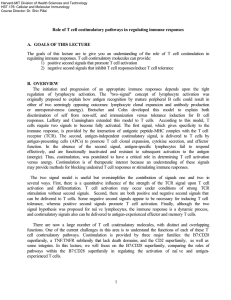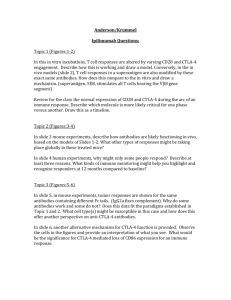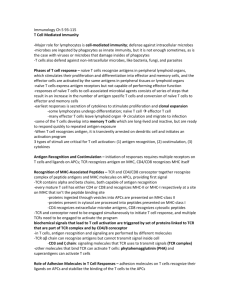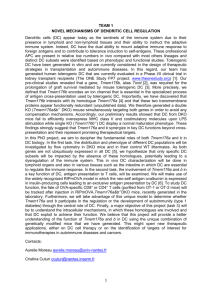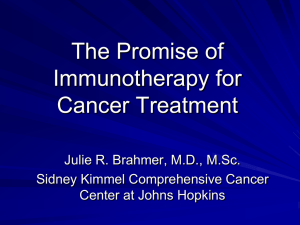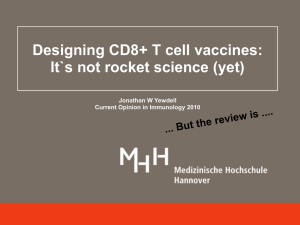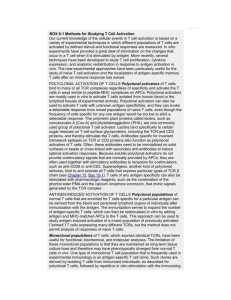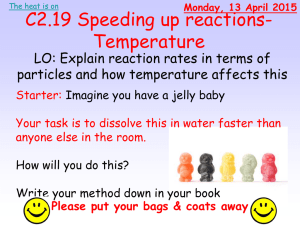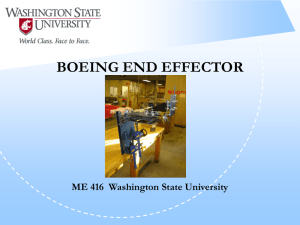Presentation
advertisement
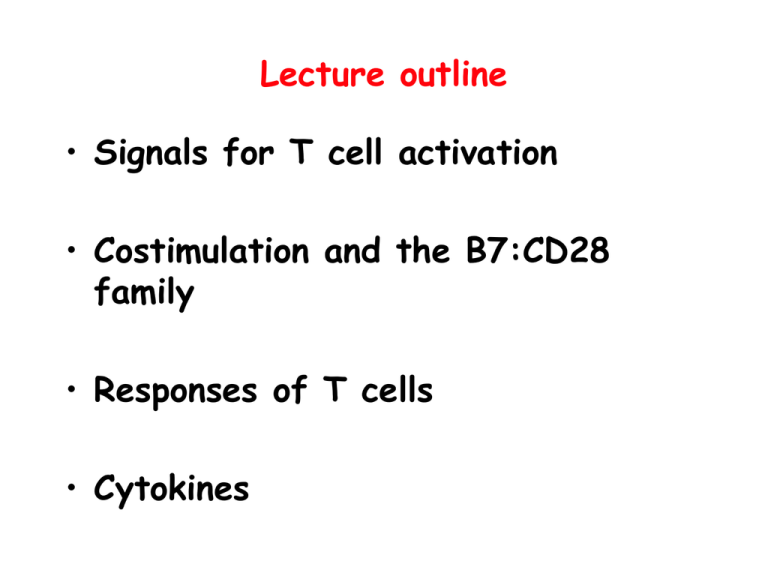
Lecture outline • Signals for T cell activation • Costimulation and the B7:CD28 family • Responses of T cells • Cytokines The life history of T lymphocytes Abbas, Lichtman and Pillai. Cellular and Molecular Immunology, 7th edition, 2011 c Elsevier Principles of lymphocyte activation • Lymphocytes are normally in a resting state in lymphoid organs and circulation • Rapid response to antigen (activation) --> proliferation, change to functionally active effector cells (differentiation) • Migration to tissues, where they perform their function of eliminating infections • Multiple possible steps for therapeutic targeting Steps in the activation of T lymphocytes Recognition of antigen by the TCR The TCR of CD4+ and CD8+ T cells recognizes MHCbound peptide + portions of the MHC. Other T cells (gd T cells, NKT cells) recognize nonpeptide antigens; these are small cell populations whose function is unclear. Antigen recognition by T cells • Each T cell sees a (self) MHC molecule and a bound peptide – Dual recognition determines specificity and MHC restriction • Multiple ligands on APCs and receptors on T cells, in addition to the TCR, participate in orchestrating responses to antigens • Signaling: clustering of receptors --> activation of kinases (often via “adaptor proteins”) --> activation of transcription factors Receptor-ligand pairs involved in T cell activation Different molecules involved in T cell responses to antigen serve distinct functions, seen even in this partial listing. Drugs that block these ligand-receptor pairs have been developed to treat immune-mediated inflammatory diseases, graft rejection. Molecules involved in T cell activation • Signal transduction – CD4 and CD8 co-receptors recognize MHC molecules (class II or class I) at the same time as the TCR sees the peptide-MHC; CD4 and CD8 provide necessary activating signals for T cells – CD28 is a receptor for “costimulators” expressed on APCs Molecules involved in T cell activation • Signal transduction – CD4 and CD8 co-receptors recognize MHC molecules (class II or class I) at the same time as the TCR sees the peptideMHC; CD4 and CD8 provide necessary activating signals for T cells – CD28 is a receptor for “costimulators” expressed on APCs • Strengthen adhesion with antigen-presenting cells – Integrins function as adhesion molecules – Affinity of integrins is increased by chemokines produced during inflammation, and by antigen recognition by TCRs • Control routes of T cell migration – Selectins and integrins control migration of naïve T cells through lymph nodes and of effector and memory T cells to sites of infection • Therapeutic targets Formation of the immunological synapse Signaling molecules orient to one region of the cell within seconds of antigen recognition Therapeutic targeting of molecules involved in T cell responses • CD3: signaling molecule attached to the TCR on all T cells; anti-CD3 MAb to deplete T cells (transplants) • Integrins (LFA-1, VLA-4, others): adhesion to APCs, endothelium; antiintegrin MAb’s to block leukocyte migration into tissues • “Costimulators”: CD28, others; costimulatory blockade The two-signal requirement for lymphocyte activation Costimulation: signal(s) in addition to antigen that are needed to initiate adaptive immune responses Best defined for CD4+ T cells Multiple pairs of ligands on APCs and receptors on T cells may serve this function; best defined are the B7-CD28 families of proteins Abbas, Lichtman and Pillai. Cellular and Molecular Immunology, 7th edition, 2011 c Elsevier Two signal requirement for T cell activation • Naïve lymphocytes need two signals to initiate their responses • Signal 1: antigen recognition – Ensures that the response is antigen-specific • Signal 2: costimulators induced on APCs during infection (or upon recognition of necrotic cells) – Ensures that the immune system responds best to microbes (or dangerous insults, such as tumors) and not to harmless antigens – Adjuvants stimulate expression of costimulators Role of costimulation in T cell activation The B7: CD28 family Different members of the B7CD28 families serve different roles in stimulating and suppressing immune responses. Major functions of selected B7-CD28 family members • B7-CD28: initiation of immune responses • ICOS-ICOS-L: role in B cell activation in germinal centers • B7-CTLA-4: inhibits early T cell responses in lymphoid organs • PD-1:PD-L1,2: inhibits effector T cell responses in peripheral tissues The opposing functions of CD28 and CTLA-4 B7 B7-CD28 interaction APC CD28 TCR Naïve T cell Proliferation, CTLA-4 B7-CTLA-4 interaction differentiation Functional inactivation Inhibitory pathways function normally to prevent responses to self antigens: demonstrated by the finding that blocking or eliminating these inhibitors (CTLA-4, PD-1) causes autoimmune disease Blocking CTLA-4 promotes tumor rejection Tumor recognition by T cells leads to engagement of CTLA-4 on the T cells and inhibition of immune responses. Blocking CTLA-4 increases anti-tumor response and leads to tumor rejection. Inhibitory role of PD-1 in a chronic infection Virus-specific T cell response Residual virus In a chronic viral infection in mice, recognition of virus by specific T cells leads to PD-1 engagement, inhibition of T cell responses, and persistence of the virus. Blocking the PD-1 pathway releases the inhibition, enhances the T cell response, and leads to viral clearance. Inhibitory receptors • Prevent reactions against self antigens • Mediate immunosuppression in chronic infections (HCV, HIV) • Limit responses to tumors • Similar roles are established for both CTLA-4 and PD-1 The balance between activation and inhibition • How does a T cell choose to use CD28 to be activated or CTLA-4 to shut down? The balance between activation and inhibition • How does a T cell choose to use CD28 to be activated or CTLA-4 to shut down? – Low B7 (e.g. when DC is displaying self antigen) --> engagement of highaffinity CTLA-4 – High B7 (e.g. after microbe encounter) --> engagement of lower affinity CD28 • Not well understood for the PD-1 pathway Therapeutics based on the B7:CD28/CTLA-4 family 1. Costimulatory blockade CTLA-4.Ig is used for diseases caused by ….? Therapeutics based on the B7:CD28/CTLA-4 family 1. Costimulatory blockade CTLA-4.Ig is used for diseases caused by excessive T cell activation -- rheumatoid arthritis, graft rejection; not yet approved for IBD, psoriasis Therapeutics based on the B7:CD28/CTLA-4 family 2. Inhibiting the inhibitor Anti-CTLA-4 antibody is used for ….? Therapeutics based on the B7:CD28/CTLA-4 family 2. Inhibiting the inhibitor Anti-CTLA-4 antibody is approved for tumor immunotherapy (enhancing immune responses against tumors) Even more impressive early clinical trial results with anti-PD-1 in cancer patients Costimulation • Required for initiating T cell responses – Many proteins on APCs and their receptors on T cells shown to “costimulate” (function with antigen to activate T cells); most important costimulators are B7:CD28 • Ensures that T cells respond to microbes (the inducers of costimulators) and not to harmless antigens – Source of costimulation in responses to tumors and transplants: products of dead cells? • Therapeutic targets # of microbe-specific T cells T cell expansion and contraction (decline) Clonal expansion 106 Contraction (homeostasis) CD8 cells 104 CD4 cells Memory 102 Infection 7 14 Days after infection 200 Many aspects of T cell responses and functions are mediated by cytokines: initial activation -- IL-2; maintenance of memory cells -- IL-7; effector functions -- various Cytokines • Secreted proteins that mediate immune and inflammatory reactions, and communications among leukocytes and other cells • Produced transiently in response to extrinsic stimuli • Bind to high-affinity receptors on target cells • Actions are most often autocrine and paracrine, rarely endocrine • Cytokines are pleiotropic (one cytokine has multiple actions) and redundant (different cytokines have similar actions) Role of IL-2 and IL-2 receptors in T cell proliferation Production of IL-2 and expression of high-affinity IL-2 receptors are both dependent on antigen recognition + costimulation Clonal expansion (proliferation) of T cells • Stimulated mainly by autocrine IL-2 – T cell stimulation by antigen + costimulators induces secretion of IL-2 and expression of highaffinity IL-2 receptors – Therefore, antigen-stimulated T cells are the ones that expand preferentially in any immune response, keeping pace with replicating microbes Clonal expansion (proliferation) of T cells • Stimulated mainly by autocrine IL-2 – T cell stimulation by antigen + costimulators induces secretion of IL-2 and expression of high-affinity IL-2 receptors – Therefore, antigen-stimulated T cells are the ones that expand preferentially in any immune response, keeping pace with replicating microbes • CD8+ T cells may expand >50,000-fold within a week after an acute viral infection with minimal expansion of cells not specific for the virus (up to 10% of all CD8+ T cells in the blood may be specific for the pathogen) • Some of the progeny of the expanded clone differentiate into effector and memory cells; the majority die by apoptosis Naïve T cells differentiate into functional effector cells Effector T cells CD4+ helper T cells + antigen Naïve T cell: Can recognize antigen but incapable of any functions Differentiation APC Cytokine secretion + antigen Show naïve CD8 also? CD8+ CTLs Cell killing Memory T cells • Long-lived, functionally silent – More numerous than naïve cells specific for the antigen; respond more rapidly than do naïve cells -- explains why secondary response is “better” than primary response • Develop from antigen-stimulated T cells • May consist of multiple subsets – Some migrate to lymphoid organs (like naïve T cells), and proliferate and differentiate rapidly in response to antigen challenge (repeat infection) – Others migrate to peripheral sites of infection, and rapidly perform effector functions upon encountering the antigen The life history of T lymphocytes Precursors mature in the thymus Naïve CD4+ and CD8+ T cells enter the circulation Naïve T cells circulate through lymph nodes and find antigens Clonal expansion; differentiation into effector and memory cells Effector T cells migrate to sites of infection Eradication of infection

